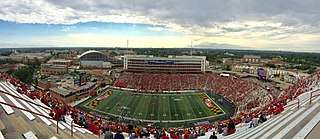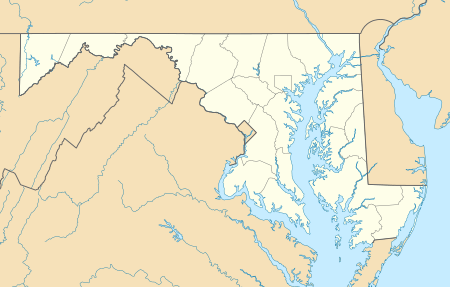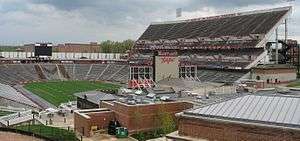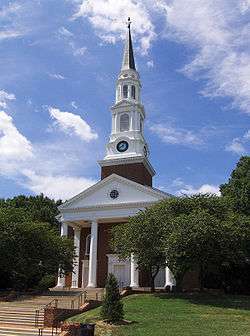Maryland Stadium
Maryland Stadium is an outdoor athletic stadium on the campus of the University of Maryland in College Park, Maryland. It is the home of Maryland Terrapins football and men's lacrosse teams, which compete in the Big Ten Conference. The facility was formerly named Byrd Stadium after Harry "Curley" Byrd, a multi-sport athlete, football coach, and university president in the first half of the 20th century.
 Maryland Stadium during a game on September 22, 2018 | |
 Maryland Stadium Location in Maryland  Maryland Stadium Location in the United States | |
| Former names | Byrd Stadium (1950–2015) |
|---|---|
| Location | 90 Stadium Drive College Park, Maryland 20742 |
| Coordinates | 38°59′25″N 76°56′50″W |
| Operator | University of Maryland, College Park |
| Capacity | 34,680 (1950–1975) 45,000 (1976–1994) 48,055 (1995–2001) 51,500 (2002–2008)[1] 54,000 (2009–2011)[2][3] 51,802 (2012–present)[4] |
| Record attendance | 58,973 (1975 vs. Penn State) |
| Surface | FieldTurf (2012–present) Grass (1950–2012) |
| Construction | |
| Broke ground | January 1949 |
| Opened | September 30, 1950 |
| Expanded | 1995, 2002, 2008 |
| Construction cost | US$1 million ($10.6 million in 2019 dollars[5]) |
| Architect | James R. Edmunds Jr.[6] Populous (renovations) |
| General contractor | Baltimore Contractors, Inc.[7] |
| Tenants | |
| Maryland Terrapins (NCAA) (1950–present) Baltimore Stars (USFL) (1985) Presidential Cup Bowl (NCAA) (1950) | |
History



Byrd Stadium, constructed at a cost of $1 million, opened September 30, 1950 in order to replace an older, much smaller Old Byrd Stadium. For 26 seasons, Maryland Stadium consisted of a horseshoe-shaped bowl with capacity of 34,680. In 1991, the five-story Tyser Tower, featuring luxury suites and an expanded press area, was completed on the south side of the stadium, as well as the Gossett Football Team House adjacent to the east endzone. In 1995, the stadium's capacity was raised to 48,055 through the addition of an upper deck on the north side of the stadium. In November 2001, as the football team once again became an ACC-title contender, temporary bleachers were brought in for an additional 3,000 seats. Those bleachers remain to this day. In 2002, a full-color video scoreboard was added in the east endzone and an expansion of the Gossett Football Team House was begun. The athletic department hoped to parlay the success of the Ralph Friedgen era into a stadium expansion that would have increased capacity to 65,000,[8] but considering that attendance has become sparse over the last several years, under Friedgen and Randy Edsall, those plans have been put on hold or abandoned. Maryland Stadium's attendance record is 58,973, set on November 1, 1975. The record was achieved with temporary seating for a game featuring the #14 Terps and #9 Penn State.[9] Lights were installed in 1985.[10]
The lone version of the Presidential Cup college football bowl game was held here in December 1950. The USFL Baltimore Stars called the stadium home in 1985. Maryland Stadium has also hosted the Division I NCAA Men's Lacrosse Championship ten times.[9]
Renaming and expansion plans
On August 24, 2006, the University of Maryland announced that it had agreed to a $20 million naming-rights deal with Chevy Chase Bank. The revenue from the deal was used to pay for renovations and upgrades to the Stadium.[11]
On April 25, 2007, the Athletic Department unveiled plans for a $50.8 million expansion to Byrd Stadium, a project that will increase overall capacity, add skyboxes complete with catered food and flat panel televisions, and lower the field to give spectators a better view.[12]
The first phase of the expansion plans has been completed and included renovating the old press tower and building 63 luxury suites that stretch from end zone to end zone. New mezzanine seating was added as well, bringing the capacity from 51,500 to 54,000.[13] A second LED video board was installed on the west side of the stadium just before the 2008 season.[12]
The second phase is to add an 8,000 seat upper deck to the stadium's west end zone bringing total seating capacity to over 60,000. This is dependent on the sale of all existing luxury suites from phase one. To date, no schedule for construction has been established.
On June 20, 2012, the Athletic Department announced plans for a new field at Byrd Stadium.[14] The installation of FieldTurf Revolution was completed in early August 2012, and included a new technology known as "CoolPlay" that reportedly keeps the field cooler (up to 15 °F cooler) than traditional turf fields with rubber infill.[15][16] It was the first installation of its kind in the United States.
Stadium name change
In 2015, the student government association agreed to a resolution in support of removing "Byrd" from the stadium's name because of Harry "Curley" Byrd's support of segregation.[17][18] On September 28, 2015, University of Maryland President Wallace Loh appointed a task force to develop viewpoints and options. The University President then made a recommendation to the University System of Maryland Board of Regents—the governing body of Maryland state universities—as to whether to change or keep the name, and the Board of Regents voted 12-5 in December 2015 to remove "Byrd" from the stadium's name, renaming it "Maryland Stadium."[19]
Harry C. "Curley" Byrd was a former football player who taught English and history and served as athletic director before rising to university president, serving from 1935 until 1954. During his tenure, the campus grew significantly, and Byrd is credited with transforming it from "an undistinguished agricultural college to something resembling a modern university."[20]
References
- "2008 Football Game Notes - Maryland vs. No. 23 California" (PDF). University of Maryland Athletics. September 2008. Retrieved September 10, 2013.
- "2009 Maryland Football Spring Prospectus" (PDF). University of Maryland Athletics. 2009. Retrieved September 10, 2013.
- "Maryland Football 2011 Preseason Notes" (PDF). University of Maryland Athletics. 2011. Retrieved September 10, 2013.
- "Maryland Football 2012 Preseason Notes" (PDF). University of Maryland Athletics. 2012. Retrieved September 10, 2013.
- Federal Reserve Bank of Minneapolis. "Consumer Price Index (estimate) 1800–". Retrieved January 1, 2020.
- "Real Estate News". The Baltimore Sun. January 8, 1950. Retrieved September 29, 2011.
- "History - Baltimore Contractors LLC". Archived from the original on July 24, 2013.
- "Facilities" (PDF). University of Maryland Athletics. Retrieved September 17, 2011.
- "Athletic Facilities". University of Maryland Athletics. Retrieved November 6, 2013.
- "Byrd Stadium to Get Permanent Lights". Washington Post. January 19, 1985.
- "Chevy Chase Bank Signs Naming Right Agreement for Byrd Stadium Field". University of Maryland. August 24, 2006. Archived from the original on August 31, 2006. Retrieved September 11, 2011.
- Carig, Marc (April 24, 2007). "Maryland's Byrd Stadium to Add Some Luxury". The Washington Post. Retrieved April 25, 2007.
- "Tyser Tower Expansion Project Progressing On Schedule" (Press release). University of Maryland Athletics. May 15, 2009. Retrieved November 6, 2013.
- "Terps Installing Unique FieldTurf Surface". University of Maryland. June 20, 2012. Archived from the original on September 24, 2012. Retrieved June 22, 2012.
- "Byrd Stadium Synthetic Turf Project is Finished". University of Maryland Athletics. August 3, 2012. Retrieved September 10, 2013.
- "Terps Installing FieldTurf Surface at Capital One Field at Byrd Stadium". FieldTurf. June 20, 2012. Retrieved June 22, 2012.
- "U-Maryland student government endorses demand that Byrd stadium be renamed, citing racist legacy". Washington Post. April 8, 2015. Retrieved April 8, 2015.
- "Student coalition seeks to get 'Byrd' off University of Maryland's stadium". Baltimore Sun. April 9, 2015. Retrieved April 9, 2015.
- Wenger, Yvonne (December 11, 2015). "Byrd Stadium to become Maryland Stadium after regents vote". BaltimoreSun.com. The Baltimore Sun. Retrieved December 11, 2015.
- Wood, Pamela (December 7, 2015). "University of Maryland president calls for renaming of Byrd Stadium - Baltimore Sun". Baltimore Sun. Archived from the original on December 7, 2015.CS1 maint: BOT: original-url status unknown (link)
External links
| Wikimedia Commons has media related to Maryland Stadium. |
| Events and tenants | ||
|---|---|---|
| Preceded by Camp Randall Stadium |
Host of the Drum Corps International World Championship 2000 |
Succeeded by Ralph Wilson Stadium |
| Preceded by Hofstra Stadium |
Home of the NCAA Lacrosse Final Four 1972 |
Succeeded by Franklin Field |
| Preceded by Rutgers Stadium I |
Home of the NCAA Lacrosse Final Four 1979 |
Succeeded by Schoellkopf Field |
| Preceded by Carrier Dome |
Home of the NCAA Lacrosse Final Four 1989 |
Succeeded by Rutgers Stadium I |
| Preceded by Franklin Field |
Home of the NCAA Lacrosse Final Four 1993 – 1997 |
Succeeded by Rutgers Stadium |
| Preceded by Rutgers Stadium |
Home of the NCAA Lacrosse Final Four 1999 – 2000 |
Succeeded by Rutgers Stadium |
